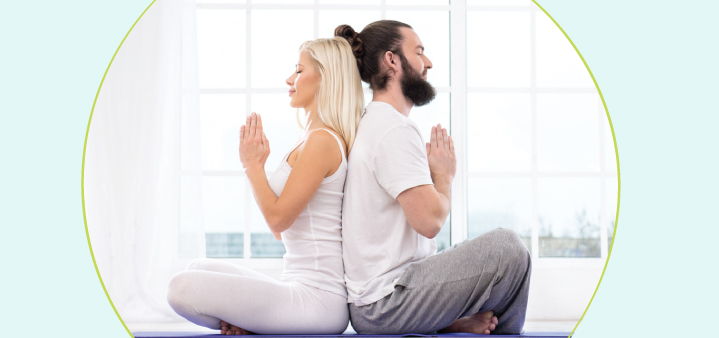Guidelines for Partner Yoga
11A few weeks ago I wrote a blog article about partner yoga, or more accurately, everything I don’t like about it. Even if I think it’s unwise, however, my yoga teacher training graduates may not agree. If you still want to teach partner yoga after my last diatribe, here are a few guidelines.
Guidelines for Partner Yoga
- Call it something other than yoga. I know I’m going to lose this battle, but I had to say it again. The classes I’ve seen that claim to be partner yoga, are really partner asana. Let’s reserve the word yoga for practices that wouldn’t make Patanjali cringe. That’s the last I’ll say on that subject.

- Provide clear guidelines on dress, hygiene, and appropriate touch. There’s a great Saturday Night Live skit in which Tom Hanks plays a sweaty yoga guy in partner yoga class. And I can only imagine that wardrobe malfunctions are all the more mortifying when someone’s standing on top of you. Don’t let your class become the next SNL skit.
- Teach partner yoga in dedicated classes or workshops, clearly advertised as such. Don’t surprise students or add it on to the end of a non-partner class. Give people the clear choice on whether or not they want to have someone else “assist” in their asana practice.
- Make sure students understand and can safely perform each asana on their own before they try it with a partner. Adding a partner increases risk. If a student can’t safely do the pose by themselves, how on earth can they be safe with a partner?
- Teach both partners how to helpfully assist. Do they understand their partner’s individual strengths and vulnerabilities? If the answer is yes, do they know how to accommodate them? If not, there’s a lot of baseline training needed before they should be hands-on with each other.
- Think of partnering as support, not leverage. The partner should never move a limb further than it can comfortably move on its own. (That principle goes for yoga teacher assists, too!)
- Pair students with appropriate height, weight and experience levels for the moves being attempted. A three hundred pound man pressing on the back of a hundred pound female is just asking for trouble.
- Choose poses that have a low risk of injury if there’s an “oops” moment. And believe me, there will inevitably be an “oops” moment. It’s safer to have people fall like dominoes out of Tree Pose than Headstand.
- Provide a safe word. I’m joking here, of course, but I think it bears mentioning. Whenever you teach something emotionally or physically risky, the student must feel comfortable saying no. State up front at the beginning of every class that no one should do any movement that makes them uncomfortable. Model that, compliment it, reward it. Doing so may save your student a trip to the ER and you a phone call to your insurance company.
The above guidelines are a bare minimum. I’m sure there are many others I haven’t thought of. If you teach or practice partner yoga, please let me know what should be added!
Republished with permission from Tracy’s Whole Life blog
 Tracy Weber is the author of the award-winning Downward Dog Mysteries series featuring yoga teacher Kate and her feisty German shepherd, Bella. Tracy loves sharing her passion for yoga and animals in any form possible.
Tracy Weber is the author of the award-winning Downward Dog Mysteries series featuring yoga teacher Kate and her feisty German shepherd, Bella. Tracy loves sharing her passion for yoga and animals in any form possible.
Tracy and her husband live in Seattle with their challenging yet amazing German shepherd Tasha. When she’s not writing, Tracy spends her time teaching yoga, walking Tasha, and sipping Blackthorn cider at her favorite ale house.
Visit her at TracyWeberAuthor.com and https://www.facebook.com/tracywe, and check out the first two books in her series. Murder Strikes a Pose and A Killer Retreat are available at bookstores everywhere!
![]() [jetpack_subscription_form title=”Read more stories from yoga teachers who found their unique voice “]
[jetpack_subscription_form title=”Read more stories from yoga teachers who found their unique voice “]






















Thanks for your post – I agree with you on all of the above. The Western compulsion to innovate and modify all things from yoga to food is worthy of questioning. A healthy practice of yoga is clear about why we do what we do, and what the benefits are – as long as you know what your true motives are you’re heading in the right direction.
Thanks for reading, Susan. I’m glad the post was beneficial to you!
I am so happy U R against partner yoga: I have gotten hurt when the instructor springs that on us in class. U R so wise: wish more local teachers would identify with your philosophy!!!
Thank you! I’m writing a book right now in which my protagonist has partner yoga “sprung” on her. Here’s hoping it will get teachers to learn how to use it more effectively–or not at all!
I’m opposed to partner yoga too and would like to read your opposition to it. Please submit it again or tell me how I can read your article on it. Thanks.
Hi Dorothy! You can read Tracy’s post about partner yoga here: http://sequencewiz.org/2015/06/19/why-i-hate-partner-yoga/
Thanks for sharing that link, Olga. And Dorothy, thanks for reading both!
Thoughtful post! I absolutely agree with all your points…and, yes, definitely call it something other than “Partner Yoga.” I have only partnered once…a really poor experience that emphasized most of your comments above. Everyone I know that teaches and/or is a student of yoga has commented that they dislike it…the only exception being couples.
Thanks, Janis. I do think partnering with couples with the express purpose of building trust can be useful. All other applications feel suspect to me.
I disagree with bringing it into class…my students have always enjoyed doing tree pose or downward facing dog or others together with a partner…I have not instructed these poses to new people or students I do not know, however. Good points but it’s too fun and rewarding to not to sometimes…
Thanks. My one question is…Are you SURE that ALL of your students like it? And how does it help your students go internal, which is the true purpose of yoga?